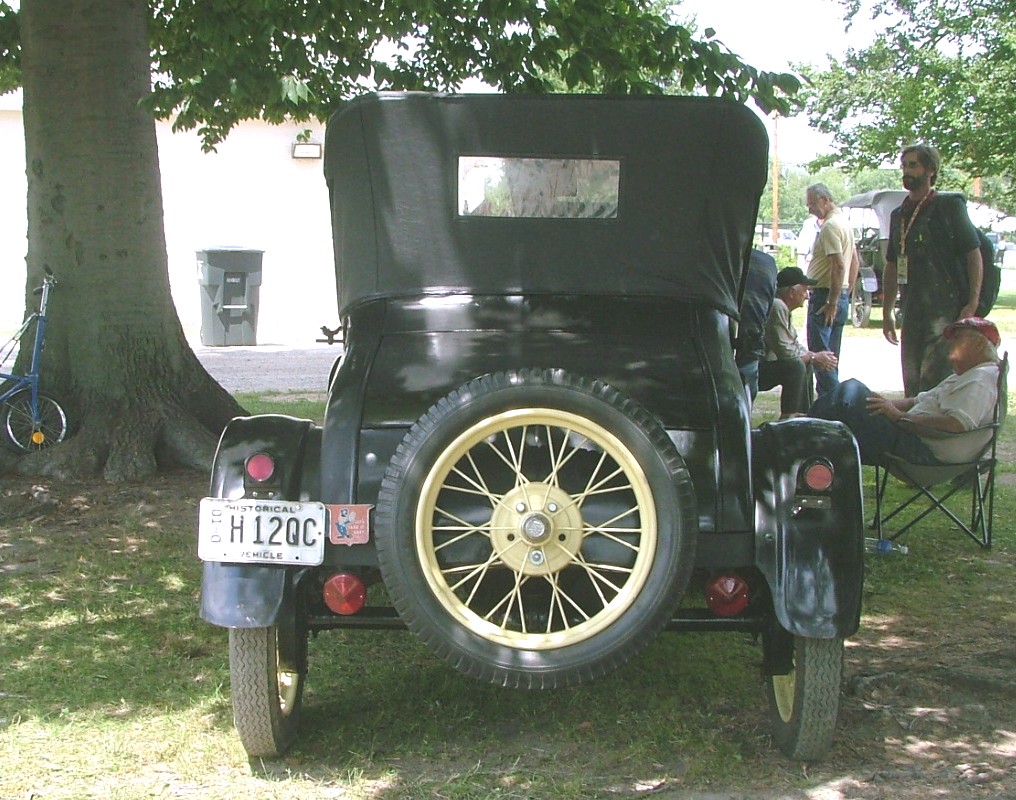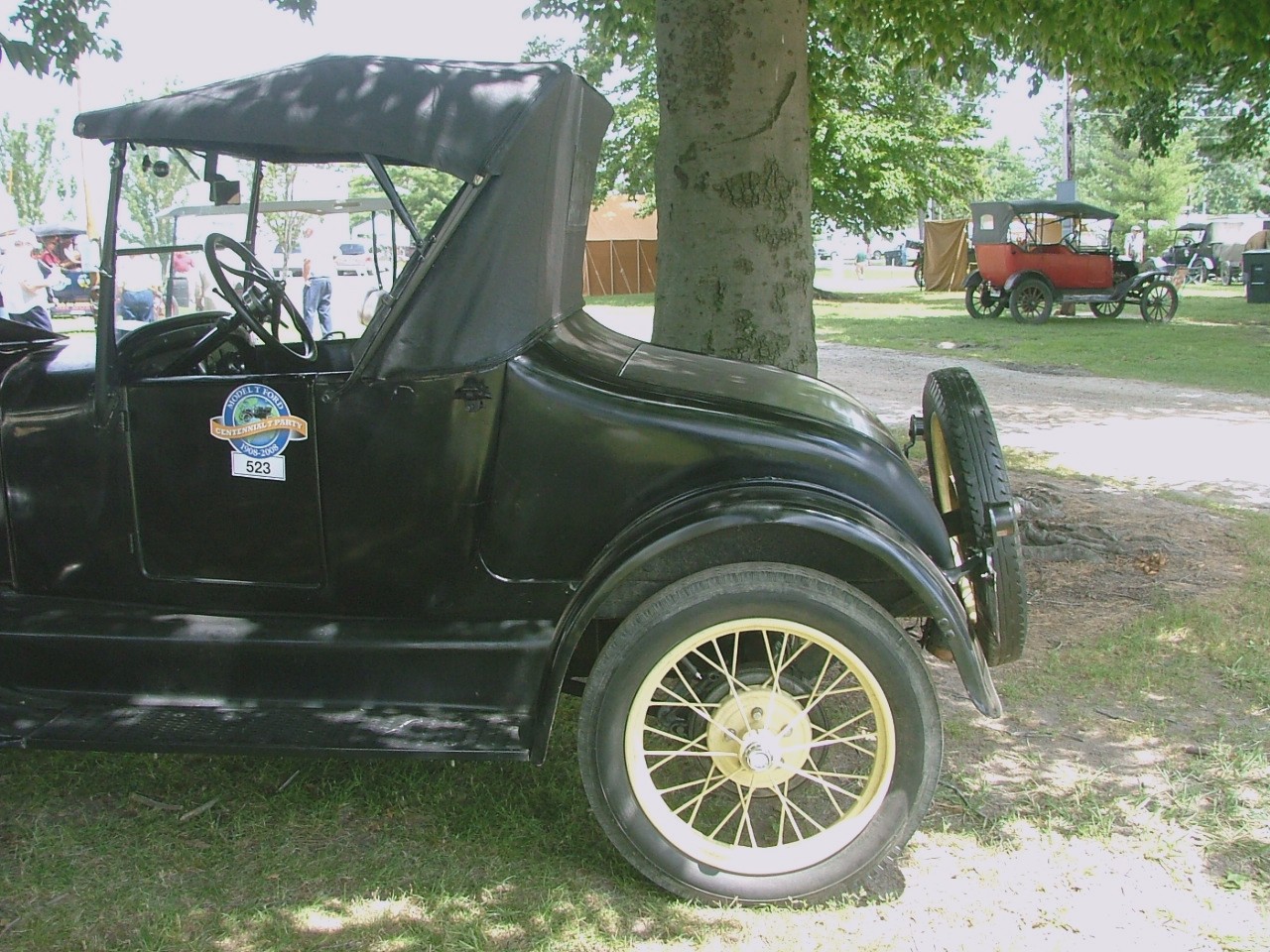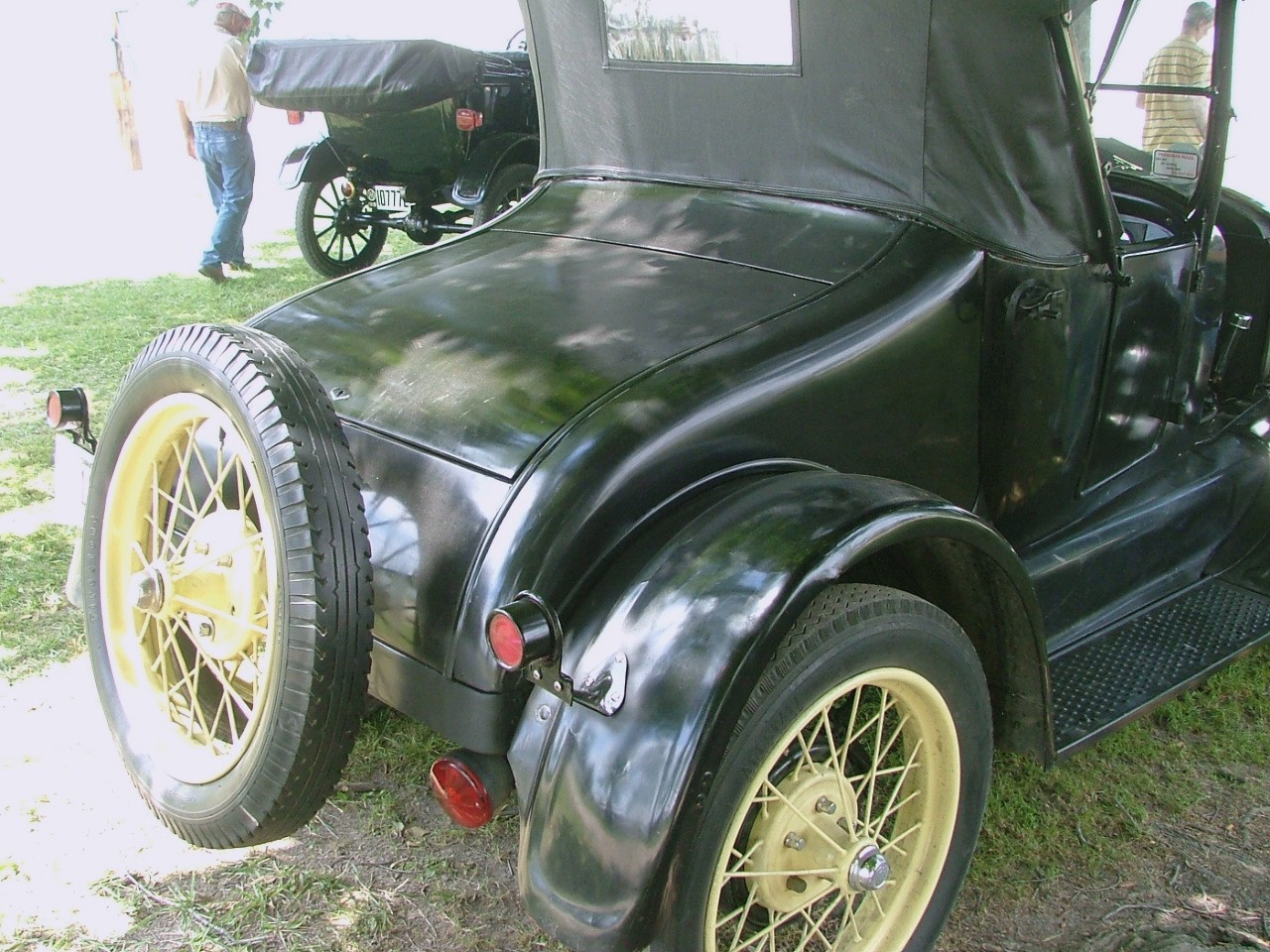
Art Anderson
Members-
Posts
5,052 -
Joined
-
Last visited
Content Type
Profiles
Forums
Events
Gallery
Everything posted by Art Anderson
-
'26/'27 turtle deck T hot rod kits requested
Art Anderson replied to Phildaupho's topic in Car Kit News & Reviews
The above pics were taken on my visit to the "Centennial T Party", hosted by the Model T Ford Club of America, at the Wayne County IN Fairgrounds, on July 25, 2008. Art -
'26/'27 turtle deck T hot rod kits requested
Art Anderson replied to Phildaupho's topic in Car Kit News & Reviews
Of course I could be wrong, but it seems to me that the basic dimensions of the Roadster "bucket" and the front "half" of the touring car body, if not exactly the same, were surely close enough to withstand any criticism. My fault for not pointing this out in the first place. The other mistake I made in my post was not saying that my intention was to show that a '26-'27 T Roadster bucket could be made from the forward half of the touring body (the body shell I showed, was intended all along to depict a cut-down touring car body on a modern street rod frame, much like one I saw at a show at The University of Notre Dame in South Bend IN, nearly 15 years ago). Back some 25 years ago, when I was ramping up All American Models (resin castings), I mastered a '27 T roadster with the turtle deck trunk, but as a street rod body--using the fender/running board/floorboard unit from the AMT '27 Touring (to get the length and width right). The technique I used on the street rod body I showed early on in this topic is the same as what I did back in 1992. The back panel of the front seat of the touring can be used, I believe, to form the back panel of a roadster body, albeit with some putty work toward the bottom, to give it a more "straight line" contour when viewed from the side. For the sides of the trunk (or "turtle deck") unit, I carved those to shape from .100" Evergreen sheet, then formed the upper and rear surfaces from strips of styrene, filed and puttied to shape, with half-round Evergreen strips for the raised moldings. As I was working from only a few images of a real '27 T roadster body back then (before I had internet access, and certainly before much in the way of photographs of the real thing were available online), I didn't know that the turtledeck actually has a slight upward curve, side-to-side, seen easily when viewed from the rear, but I now have reference pics that clearly show the correct shape and contour: Art -
1/24 Monogram '30 Ford Cabriolet - Special Interest Series
Art Anderson replied to Casey's topic in Car Kit News & Reviews
Except that Monogram NEVER kitted a stock Model A Roadster of any year! You may be confusing the Cabriolet (subject of this thread) when it's been photographed with the top in the folded position. Art -
Eric, I have several of Chris's Offenhauser engines. His was mastered off of a real 274cid Offy (4.5 liter, used in Indianapolis Car racing from 1935 through the 1955 USAC season. I also have, started but not yet finished, his first Indianapolis car kit, the 1925 Duesenberg Indianapolis winner, which when finished, will be a model of the 1927 Indy winner, driven by the last "true" rookie to win at Indianapolis, George Souders, from my hometown of Lafayette IN, and whom I got to know pretty well in his later years. In addition, I have, now higher on my build list, Chris's excellent curbside model kit of Frank Lockhart's "Stutz Blackhawk Spl, the ill-fated LSR in which Lockhart was killed, on the beach at Daytona Florida, in 1927.
-
Chris was a consummate model builder. He was, to put it mildly, a "child prodigy" when it came to building plastic models. He'd come into the hobby shop here in Lafayette, where I worked my way through college and for 3 years afterward, with his two older brothers (Chris was about 7 or 8 when he started, with WW-II airplane kits) who were in their mid-late teens at the time. By the time Chris was 12 or 13, he was competing, and being awarded at IPMS contests, entering as an ADULT. At the IPMS Nationals at Bong International Airport in Milwaukee, Chris won several firsts. One thing almost nobody ever knew: Chris built many a 1/43 scale Ferrari for none other than Jay Leno, for a good number of years! About 2001, Chris started his first resin-casting venture--Medallion Models, a company producing resin transkits for 1/48 scale aircraft, principally WW-II birds, but was caught up by the sudden entry of several new model companies in Eastern Europe and in the Far East. In 2004, began working on his first 1/25 scale Indianapolis Winner, the 1925 Duesenberg race car driven to victory by Peter DePaolo that year, and by Lafayette IN (both of our's hometown) Native, George Souders, complete with a Fred Novarro figure of Souders. In 1997, Chris joined me at both NNL West and NNL East--selling out everything he took to each show well before the end of the event. In the summer of 2002, he shut down ESC, opting to go back to college, and the John Herron School of Art in Indianapolis, and then began a new career doing artwork for a sports apparel company in Indianapolis, but continued his personal hobby of building 1/43 scale racing cars. He will be missed, but fondly remembered, by all who knew him. Art Anderson
-
1/25 AMT '65 Lincoln Continental Customizing Kit
Art Anderson replied to Casey's topic in Car Kit News & Reviews
Not really. Other than the manufacturer of the real cars, Ford Motor Company, Lincolns never shared any sheetmetal or structure with any full-sized Ford back in those days. They did share a lot of structure, even the same basic platform (albeit in a much longer wheelbase) with Thunderbird from 1958 onward though. -
Posted just a little while, on Facebook: Chris Etzel, the creator of those fabulously accurate and detailed "Etzel's Speed Classics" passed away earlier today, from cancer. I first met Chris while working my way through college at Weber's Hobby Shop here in Lafayette IN--at perhaps 5 yrs old, he would tag along with his two older brothers when they came in to the shop to buy model kits and supplies. By about 1980, in high school, he was one heck of a modeler, passionately building 1/48 scale aircraft, winning big at IPMS Regionals and Nationals. In the mid-1990's, after a try at doing 1/48 scale aircraft resin transkits, he hit on the idea of replicating famous Indianapolis cars, and "Etzel's Speed Classics" was born. His passion for creating "That last and correct detail" became legendary, along with the sheer accuracy of each and every kit he produced. While ultimately, by about 2004, Chris had to shut down his resin/white metal race car production and pursue other opportunities, he never gave up his love for racing and race cars--building awesome 1/43 scale F-1 cars all the way out until his failing health caught up with him just a couple of weeks ago. RIP Chris, and thanks for all the memories, and some really great kits. Art
-
Ertl, whose casting I used in the Johnny Lightning 1/24 scale series, produced two other Bantam commercial vehicles in the same 1/22 scale: A closed cab pickup, and a model of one of the three custom roadster pickups done by American Bantam, for an auto parts store in Atlanta GA--Have those two in the original livery that Ertl produced them in, but buried rather deeply right now. Art
-
I wonder if the mold is busted.
Art Anderson replied to Lovefordgalaxie's topic in General Automotive Talk (Trucks and Cars)
Actually, this is more common than you might think, with modern-made model kit tooling. it's easier to do it that way, and doesn't really add very much to the production cost. Art -
Since the kit was produced, for Dave, by Moebius Models--you might try contacting Moebius directly. Art
-
What would YOU like to see as a model
Art Anderson replied to JeroenM3's topic in General Automotive Talk (Trucks and Cars)
That I did, Luc--using parts and panels from Monogram's Pro-Street '86 TBird, then cast in resin as a complete transkit. Sales were, shall we say, "underwhelming" though. -
It appears that the third (last picture) shows the car at check-in, tech inspection. The other two pics are either race day or very close to that in practice, and the rear spoiler is CLEARLY yellow. Such detail changes were, and still are, quite common, during the time frame from when a race car arrives for a major racing event, going through practice, and finally on race day. As for the "shade" of yellow, who knows now just exactly that was, looking at photo's taken 50 some years ago? If it were my model, I'd be very comfortable using Testors 1114 Gloss Yellow--I can't imagine anyone arguing against that, with any credibility whatsoever. Art
-
What would YOU like to see as a model
Art Anderson replied to JeroenM3's topic in General Automotive Talk (Trucks and Cars)
Except that "product promotion" isn't the key phrase here: There are those of us here that will remember back in the early 1980's, when outfits in Korea and Taiwan were suddenly flooding the auto parts stores with counterfeit GM parts, right down to the GM logo and parts number on the boxes. GM went to court over that, as we'd expect them to have done, and ultimately won in the US Supreme Court. The gist of the decision is that any company (or for that matter, any person--and legally, corporations ARE persons) having products and/or trademarks they wish to protect from unauthorized copying, has every right to do just that--but they must do so by taking on all comers. Any manufacturer or other entity owning what is called "intellectual property" (and automobiles and their designs are exactly that: Owners of intellectual properties) simply must take steps to "protect" those properties, or face seeing them fall into what is called "The Public Domain". Can you imagine, for example, GM losing say, the Corvette to becoming something that anyone can manufacture, call it what it is, even slap "Chevrolet" on it? Or Ford, or what is now FCA? Chaos, as far as all manner of industry, of all kinds and types. For automakers doing business in the US, that means requiring anyone wanting to produce products that replicate their products, their marques, submit such product for examination and approval--and then require those persons to apply for permission to reproduce whatever it is they want to manufacture. While as a general rule, the automakers have never been bothered by the micro-small model car aftermarket people (Although I did have a run-in with GM, over a certain GMC pickup grille and a 1970-72 series of Cutlass 442 W-30 convertibles). Basically, how automobile model kit licensing works is, the model company submits a tooling mockup to the licensor (or their agent) for approval of the design (is the model a reasonably good, accurate representation of the real thing? Will it have the correct badges and/or scripts? Those sorts of things). Once the automaker (or its agents) approves the proposed model, then a licensing fee (OK, royalty if you will) will be on the table: "How much is the MSRP to be?" "How large a production run is anticipated?" --those are critical issues to be addressed by both parties. The bottom line becomes that in the end, a set fee is agreed upon, payable up front, for whatever the expected production number(s) will be; and for a specified period of time (could be months, could be multiple years). Over that time frame, there will be moments of accounting, where the licensee reports the actual production of such product, and at the end, there may well be some negotiating if the expected production and sales didn't meet the expectations going in. Such royalty payments, while not small in their aggregate, generally exorbitant, but they are necessary, for all the reasons stated above. And, if a certain model car subject failed to meet the expected sales number, by the end of the licensing period, often times the unused funds can be moved forward, as part of the royalty for a new subject (saw that happen more than once when doing product development of Johnny Lightning diecast miniatures. -
So nice, I can close my eyes, hear the wooden body creaking as this one rolls down a dirt road! Art
-
Very nice indeed! All it needs now is that obligatory cloud of blue oil smoke from the exhaust! Art
-
1/25 MPC Jeep CJ-5 WWII/Korean Conflict Staff Car & Trailer
Art Anderson replied to Casey's topic in Truck Kit News & Reviews
FWIW, neither MPC Jeep (the Hogan's Heroes Jeep, or the the CJ-5 kit) are WW-II Jeeps. Their "Hogan's Heroes" kit actually is a model of a 1946-the 60's Jeep CJ-2A, which was the civilianized Jeep introduced right at the end of WW-II. It really cannot be built as a true WW-II Jeep, due to several body shell changes that were done to make it more palatable to civilian buyers after the war. Actually, most all the miltary hardware in that kit is correct for the Korean Conflict/Early NATO, as the CJ-2 was "remilitarized" in early 1951, as the US Army M-38. The 105mm Recoilless Rifle in that kit is a Korean War-era weapon, not seen in WW-II. MPC's "Korean War" Jeep is the Kaiser-Jeep CJ-5, which in its military dress, did not serve in Korea, as it was first produced in 1954, nearly a year after the Korean Armistice--first as the military M38A2 (with a split windshield), and then as the CJ-5. It has the Kaiser-Willys developed Jeep Hurricane 4cyl, which is an F-head unit (one set of valves in the block--the other set of 8 valves in the head as with a fully overhead valve engine. Both are, however, very nice kits, and build up very nicely indeed. Art -
Yes, all three are "one and the same" as the MPC kits produced in the mid-1980's. Bear in mind, that in 1986, Ertl bought up all the existing MPC tooling, produced those kits under the MPC Ertl brand for years. Ertl began rebranding MPC kits as AMT, due to what is perceived to be the better brand-recognition that AMT has (not sure that's true, but it is what it is). Art Art
-
'26/'27 turtle deck T hot rod kits requested
Art Anderson replied to Phildaupho's topic in Car Kit News & Reviews
Simple as pie! On all Model T Fords, the "turtle deck" (trunk, actually) was never part of the roadster body, but rather a bolted on unit. Remove that, bolt in place the pickup box--and PRESTO, a Model T Ford Roadster Pickup! That is exactly what Ford did, when in 1925, they became the very first automaker to mass-produce a pickup truck, and the assembly sequence stayed the same for 1926-27. Now, I may have written about this one before! The early AMT "Sell Sheet" showing a '27 T/XR-6 Trophy Series kit, SHOWED a stock '27 Roadster, but that was quickly changed, to show the Touring Car. Even though the Roadster and Roadster pickup '27 T was never done by AMT--it's not rocket science to make one. For 1926, Ford's roadster was very simply, just the front half of the touring car body--which can easily be done using the back panel of the front seat of the Touring, and cutting away the rear portion of the Touring body as you can see in this picture. That is a stalled project from about 10 yrs ago or so, for a "bob-tailed" '27 T hot rod. For the pickup box, simply use the box from the AMT '25 T Double Kit, which is still about as plentiful as popcorn. ARt -
The French Ford Flathead
Art Anderson replied to rel14's topic in General Automotive Talk (Trucks and Cars)
Don't know about the French, but the US air compressor manufacturer Schramm built large aircompressors out of US-produced Ford flathead V8's! -
The French Ford Flathead
Art Anderson replied to rel14's topic in General Automotive Talk (Trucks and Cars)
I believe that French flathead mentioned, was pretty much the same as Ford's heavy duty truck V8 (which also went on to power the 1949-51 Lincolns. Ford of France and later, Simca also produced a variant of the diminuitive V8-60, and that engine out into the 1960's. Art -
What would YOU like to see as a model
Art Anderson replied to JeroenM3's topic in General Automotive Talk (Trucks and Cars)
The biggest "fly in the ointment" is determining what subject(s) would sell enough units, to not only pay the development/tooling costs, but leave some profit $$ in the till, to fund that next new kit. Virtually all the "high profile" car subjects have been done, some many times, in kit form already. Some subjects are so perennially popular, they seem almost like corn flakes, make more of them, people will buy them. So many other subjects however, really are in "missionary sale" territory--and those can be tough to move. Art


.jpg.bce7202410de2a9482a8ce94a86496bb.jpg)



